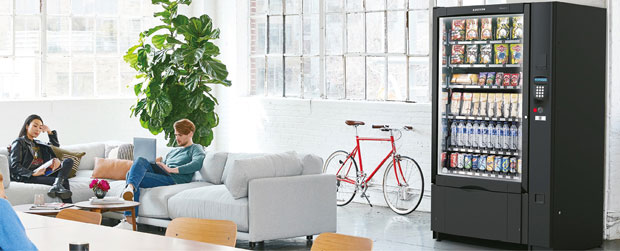 A new healthy eating framework to improve health and wellbeing within the NHS is being supported by the vending industry. Westways Vending Finance Director, Natalie Baker explains the concept
A new healthy eating framework to improve health and wellbeing within the NHS is being supported by the vending industry. Westways Vending Finance Director, Natalie Baker explains the concept
Over the years, the perception of vending machines has changed. There is an increased call from people who want to continue enjoying the convenience of vending machines, but who also want to access a healthier, more balanced range of product choices. A wide variety of vending machine operators now regularly work to ‘The Commissioning for Quality and Innovation (CQUIN) framework’, put in place by the NHS. This framework enables us, not just as operators but as an industry as a whole, to be accountable for the product ranges being offered to our customers.
It’s a staggering fact that almost 25 per cent of adults in England are obese, and significant numbers are overweight. Notably, sugar intakes for all population groups are also above government recommendations. However, people are becoming increasingly aware of their dietary intake and there is a real drive to help motivate and encourage change in eating habits.
WHAT IS CQUIN?
The CQUIN framework covers a number of areas designed to drive change within the NHS. Thirteen specific indicators have been published to date. The first of these indicators is “Improving Staff Health and Wellbeing” and refers to food provision.
The aim is not to ban any products outright but instead, restrict promotions and advertisements of less “healthy” foods, and in turn, restrict the sales of less “healthy” foods. NHS trusts that adhere to the CQUIN schemes can receive additional funding. Although developed by the NHS, vending machine operators have found that the guidance has been routinely taken up by a number of other industries. This is because the framework is thorough, concise, and offers a more balanced alternative to a traditional vending machine product range.
The Government Buying Standards does not specify a definition of what is “healthy”. Instead, it focuses on calorie content. The guidelines include:
- Savoury snacks should only be available in pack sizes of 30g or less.
- Confectionery and packet sweets should be the smallest single serve portion size available on the market and contain no more than 250kcal.
- All sugar sweetened drinks should be in packs no bigger than 300ml.
- No less than 80 per cent of the drinks in the machine should be low calorie or no added sugar (including fruit juice and water).
The framework also states that there must be the availability of healthy, low-calorie options for night shift workers. This is key when considering the stock planning in vending machines on a site. While a traditional shop or kiosk may not be able to stay open to cover these night shifts, a vending machine can take their place and continue to fulfil the brief for healthy, sustainable refreshments, whatever the time (or place).
INTRODUCING CLIENTS TO HEALTHIER OPTIONS
Some clients and customers may be keen to make the switch. For sites that would like to make the move, it’s best to carry out a sample test of a new line. This will help you find out if people like what is being introduced and how the product sells. It is worth noting, as per the Automatic Vending Association, that vending machines in hospitals perform best between 8am and 2pm. This therefore could be the ideal time to test any new products. But different customers like different things and so products could perform differently during the night and day. Perhaps consider offering some samples of new products, to encourage people and to see which of the products they prefer.
HOW OFTEN WOULD YOU BUY A FOOD OR DRINK ITEM THAT SAYS THE WORD “HEALTHY”?
Research has shown that typically, people do not buy products labelled in this way. They buy on taste instead. It is vital to include a wide variety of items that actively entice and appeal to a consumer. There is a huge range of well-known brands in the low-calorie market that taste great and appeal to a mass market. These products have successfully managed to fulfil the CQUIN requirements and have cross appeal to other industries. There is no reason why a CQUIN compliant vending machine cannot work in any staffroom, canteen, warehouse – just about anywhere. Vending machine operators can work to custom planograms to make sure that each site has the stock they need to suit their needs.
CQUIN compliant vending is a step forward in the world of workplace refreshment. If offers the opportunity to encourage real change in eating habits and in turn, people’s health.
Clear packaging and product labelling also mean that consumers have a choice in their purchasing and eating habits. CQUIN guidance ensures that operators work to strict planograms when stocking machines, giving companies’ peace of mind about the food coming into their workplace. Operators can monitor what products are selling well and what aren’t and can make changes quickly and efficiently. This means that sales are kept high, and income (and demand) remains consistent.





